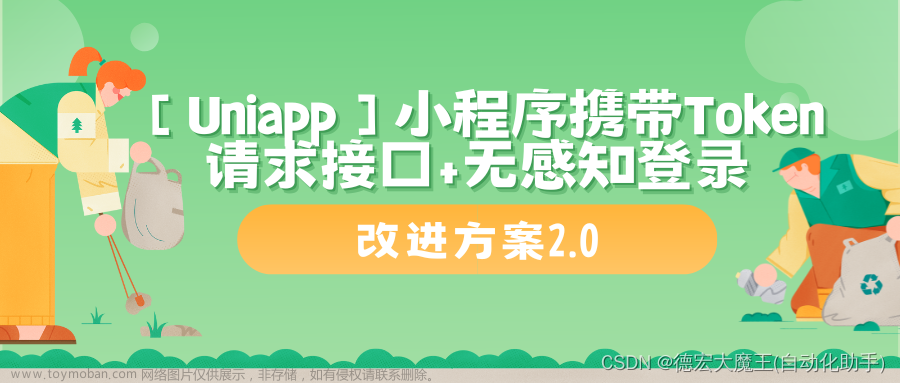目的
导入SpringSecurity的SpringBoot项目,在连接WebSocket时进行token校验
实现
SpringBoot整合Websocket的相关知识就不过多赘述,本文主要介绍WebSocket权限校验相关
1. 前端
WebSocket连接
var windowTag = `${user.id}-${Math.random().toString(36).substr(2)}`;
var token = user.token;
websocket = new WebSocket(`ws://localhost:9001/ws/chat/${windowTag}`,[token]);
windowTag是生成的随机窗口唯一标识符,token是用户登录后生成的令牌token
当前端发起WebSocket连接请求时,请求头在通信子协议Sec-WebSocket-Protocol里携带token
2. 后端
前端通过WebSocket的通信子协议携带token发送给后端,现在我们只需要获取到该token就能获取用户信息
/**
WebSocket配置
*/
@Configuration
public class WebSocketConfig extends ServerEndpointConfig.Configurator {
@Bean
public ServerEndpointExporter serverEndpointExporter(){
return new ServerEndpointExporter();
}
/**
* 建立握手时,连接前的操作
*/
@Override
public void modifyHandshake(ServerEndpointConfig sec, HandshakeRequest request, HandshakeResponse response) {
// 这个userProperties 可以通过 session.getUserProperties()获取
final Map<String, Object> userProperties = sec.getUserProperties();
Map<String, List<String>> headers = request.getHeaders();
List<String> protocol = headers.get(WEBSOCKET_PROTOCOL);
// 存放自己想要的header信息
if(protocol != null){
userProperties.put(WEBSOCKET_PROTOCOL, protocol.get(0));
}
}
/**
* 初始化端点对象,也就是被@ServerEndpoint所标注的对象
*/
@Override
public <T> T getEndpointInstance(Class<T> clazz) throws InstantiationException {
return super.getEndpointInstance(clazz);
}
}
将请求头中Sec-WebSocket-Protocol携带的token放入session的userProperties中,方便连接时获取token
@Slf4j
@Component
@ServerEndpoint(value = "/ws/chat/{windowTag}",configurator = WebSocketConfig.class)
public class ChatEndPoint {
//用线程安全的map来保存当前用户
private static Map<String, ChatEndPoint> onlineUsers = new ConcurrentHashMap<>();
//声明一个session对象,通过该对象可以发送消息给指定用户,不能设置为静态,每个ChatEndPoint有一个session才能区分.(websocket的session)
private Session session;
//建立连接
@OnOpen
public void onOpen(Session session, @PathParam("windowTag") String windowTag){
this.session = session;
String username = getUserName(session);
log.info("上线用户名称: {}", username);
onlineUsers.put(username + "-" + windowTag, this);
log.info("在线用户数: {}", onlineUsers.size());
}
......
// 获取用户名
private String getUserName(Session session){
String token = getHeader(session, WEBSOCKET_PROTOCOL);
return new TokenManager().getUserInfoFromToken(token);
}
public String getHeader(Session session, String headerName) {
String header = (String) session.getUserProperties().get(headerName);
if (StringUtils.isBlank(header)) {
try {
session.close();
} catch (IOException e) {
e.printStackTrace();
}
}
return header;
}
}
通过子协议中携带的token获取用户名,并与窗口标识符拼接成连接标识符,之后将连接的session存放进线程安全的Map中
/**
SpringSecurity的权限校验器
*/
public class TokenAuthFilter extends BasicAuthenticationFilter {
private TokenManager tokenManager;
public TokenAuthFilter(AuthenticationManager authenticationManager, TokenManager tokenManager) {
super(authenticationManager);
this.tokenManager = tokenManager;
}
@Override
protected void doFilterInternal(HttpServletRequest request, HttpServletResponse response, FilterChain chain) throws IOException, ServletException {
System.out.println("根据token获取用户权限并放入security上下文...");
// websocket需要验证Sec-WebSocket-Protocol中的token
String token = request.getHeader(WEBSOCKET_PROTOCOL);
if(token == null){
token = request.getHeader("token");
}
//获取当前认证成功用户权限信息
UsernamePasswordAuthenticationToken authRequest = getAuthentication(token);
//判断如果有权限信息,放到权限上下文中
if(authRequest != null) {
SecurityContextHolder.getContext().setAuthentication(authRequest);
}
chain.doFilter(request,response);
}
private UsernamePasswordAuthenticationToken getAuthentication(String token) {
System.out.println("请求头中的token: " + token);
if(!token.equals("null")) {
//从token获取用户名
String username = tokenManager.getUserInfoFromToken(token);
System.out.println("token获取用户名:"+username);
//从token获取对应权限列表
List<String> permissionValueList = tokenManager.getUserPermissionList(token);
Collection<GrantedAuthority> authority = new ArrayList<>();
if(permissionValueList != null){
for(String permissionValue : permissionValueList) {
SimpleGrantedAuthority auth = new SimpleGrantedAuthority(permissionValue);
authority.add(auth);
}
}
return new UsernamePasswordAuthenticationToken(username,token,authority);
}
return null;
}
}
在SpringSecurity权限校验时先获取Sec-WebSocket-Protocol携带的token
当我们以为一切准备就绪时,运行时发现报错了
WebSocket握手阶段出错:发送了非空“Sec-WebSocket-Protocol”请求头但是响应中没有此字段。在后端握手时设置一下请求头(Sec-WebSocket-Protocol)即可,前端发来什么值,这里就写什么值文章来源:https://www.toymoban.com/news/detail-443519.html
@Order(1)
@Component
@WebFilter(filterName = "WebsocketFilter", urlPatterns = "/ws/**")
public class WebSocketFilter implements Filter {
@Override
public void doFilter(ServletRequest servletRequest, ServletResponse servletResponse, FilterChain filterChain) throws IOException, ServletException {
HttpServletResponse response = (HttpServletResponse) servletResponse;
String token = ((HttpServletRequest) servletRequest).getHeader(WEBSOCKET_PROTOCOL);
// 解决 Sent non-empty 'Sec-WebSocket-Protocol' header but no response was received
response.setHeader(WEBSOCKET_PROTOCOL,token);
filterChain.doFilter(servletRequest, servletResponse);
}
@Override
public void destroy() {}
}
连接成功!!

功能测试 文章来源地址https://www.toymoban.com/news/detail-443519.html
文章来源地址https://www.toymoban.com/news/detail-443519.html
到了这里,关于SpringSecurity整合WebSocket并携带token的文章就介绍完了。如果您还想了解更多内容,请在右上角搜索TOY模板网以前的文章或继续浏览下面的相关文章,希望大家以后多多支持TOY模板网!










